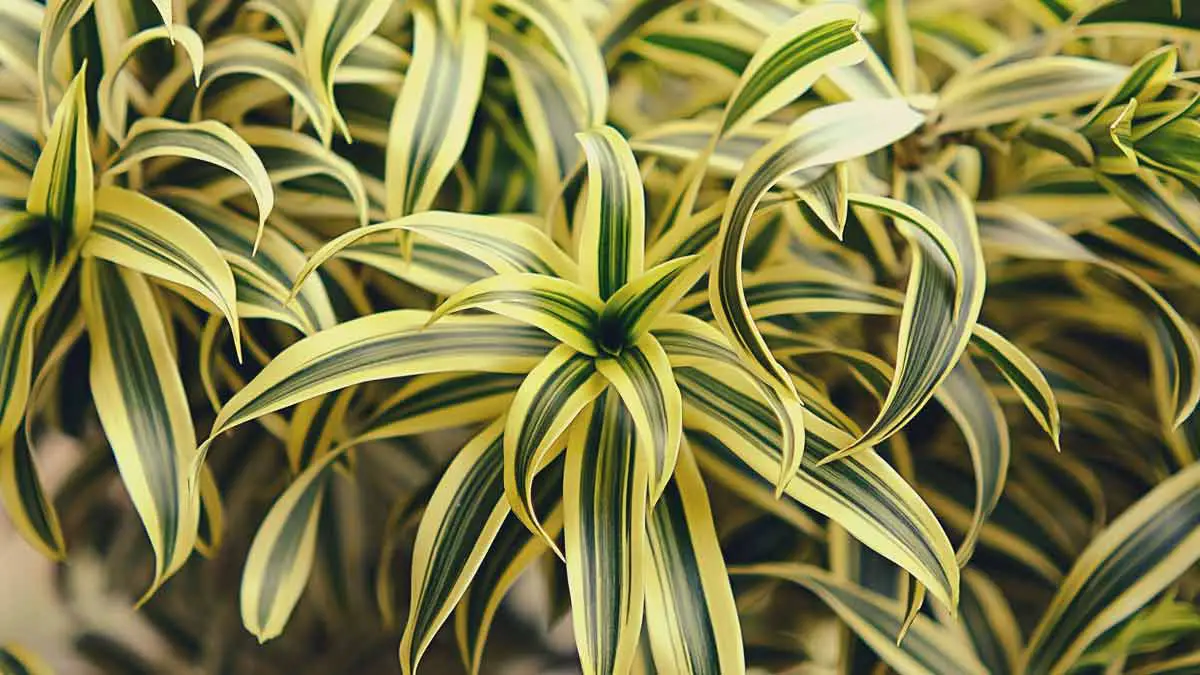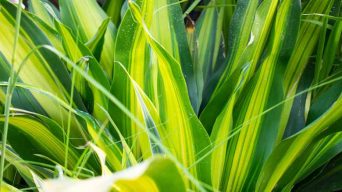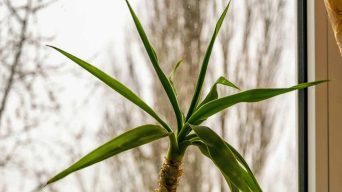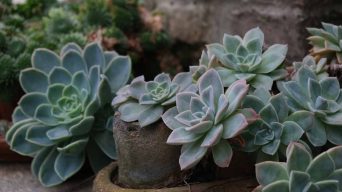Dracaenas grow well outdoors in a well-draining soil amended with organic matter. They prefer bright, indirect light and are best suited for USDA zones 9-11 with sub-tropical climates. They should not be exposed to direct sunlight.
Dracaena plants, loved for their lush foliage and easy-care nature, have been popular with indoor gardeners.
However, many plant enthusiasts are unaware that these tropical beauties can thrive outdoors!
In this comprehensive guide to growing Dracaena outdoors, we’ll explore everything you need to know, from selecting the perfect variety and preparing your outdoor space to proper planting techniques and essential care tips.
Selecting The Right Dracaena Variety For Outdoor Growing
Amidst the lush greenery of the great outdoors, selecting the perfect dracaena variety is a crucial decision for any garden enthusiast.
The perfect outdoor oasis can be achieved with the right factors, such as climate, light conditions, and desired growth habits.
Popular Dracaena Varieties Suitable For Outdoor Growing
Growing Dracaena outdoors can be a rewarding experience, as these plants are known for their lush foliage and unique growth habits.
Here is a list of popular dracaena varieties that are suitable for outdoor growing:
- Dracaena marginata (Dragon Tree): A popular choice due to its colorful leaves and tree-like appearance; it grows well in partial shade to full sun.
- Dracaena arborea: Native to Africa, this species can grow up to 15 meters tall and is an excellent statement piece in any garden.
- Dracaena reflexa (Song of India): With its twisting stems and bright green leaves with yellow edges. This variety adds interesting texture to outdoor spaces while tolerating partial shade.
- Dracaena fragrans (Corn Plant): Known for its long, glossy green leaves, this variety thrives in bright indirect light or filtered sunlight.
- Dracaena surculosa (Florida Beauty): This compact variety features attractive gold-spotted foliage and is perfect for adding color to your garden or patio containers.
- Dracaena sanderiana (Lucky Bamboo): Although traditionally grown indoors, lucky bamboo can thrive outdoors in milder climates with morning sun and afternoon shade.
- Dracaena deremensis ‘Janet Craig’: This classic houseplant can also be grown outdoors in a shady location with well-draining soil.
Factors To Consider When Selecting The Right Dracaena Variety
Selecting the right dracaena variety for your outdoor space encompasses many factors.
It is critical to consider the specific climate conditions where you reside, as certain dracaena species may thrive better in particular environments than others.
Additionally, assess your garden or patio area’s soil type and light conditions.
Most dracaenas prefer well-draining soil with access to bright indirect light, so avoid areas prone to waterlogging and direct sunlight exposure.
Watering requirements also play an essential role when choosing a suitable dracaena outdoor variety.
While these plants possess forgiving nature towards water availability fluctuations, understanding their preferences can significantly boost their longevity and overall health.
Lastly, reflect upon your desired plant aesthetics – from height and leaf coloration patterns to textures – since these elements will ultimately influence how harmoniously they blend into your landscape design while providing visual appeal throughout various growing seasons.
Tips For Choosing The Right Dracaena Variety For Your Outdoor Space
Consider your outdoor space and specific requirements when selecting the ideal dracaena variety to grow.
Start by evaluating the available sunlight in the area, as dracaena plants prefer bright indirect light.
Size constraints should also be considered, as some species can grow large over time. Smaller varieties like Lucky Bamboo (Dracaena sanderiana) and Janet Craig (Dracaena fragrans) are well-suited for more compact spaces or container growing.
Additionally, consider local climate conditions – certain types, such as Dracaena Draco, can withstand cooler temperatures better than others but may struggle if kept indoors during colder months if proper care isn’t provided.
Preparing The Outdoor Growing Space For Dracaena
Under the sun’s warm embrace, the lush foliage of Dracaena thrives in the great outdoors.
The key lies in meticulous preparation to cultivate a vibrant and healthy garden.
With careful consideration of planting location, soil amendment, and adequate spacing, the stage is set for a verdant and flourishing display of these beloved ornamentals.
Choosing The Perfect Planting Location
The perfect planting location for outdoor dracaena plants is essential for their health and growth.
When selecting a spot, it’s important to consider the amount of sunlight the plant will receive, soil type, and space availability.
Most dracaena varieties prefer bright indirect light or partial shade, so placing them in an area with direct sun exposure can cause damage to their leaves.
Additionally, tropical plants require a consistently warm environment to thrive.
Regarding soil type, choose well-draining options that won’t retain water around the roots and lead to root rot.
If you’re planting directly into the ground instead of using containers, ensure adequate space for growth, and competition with other nearby plants isn’t too harsh.
Soil Preparation
Proper soil preparation is essential when planting Dracaena outdoors.
To ensure the plant thrives, you’ll need well-draining soil rich in nutrients.
It’s also important to test your soil before planting to determine its pH level and adjust it accordingly.
Dracaena prefers slightly acidic soil with a pH of 6.0-6.5.
In addition, make sure that the outdoor growing space has good drainage. Poor drainage leads to waterlogging and root rot, quickly killing Dracaena plants.
These simple tips for preparing your outdoor space for Dracaena will provide optimal conditions for healthy growth and beautiful foliage all season long!
Providing Adequate Space For Growth
Dracaena can grow to be quite large and require ample space for growth.
Ensuring enough room for the plant to mature entirely is essential when preparing the outdoor growing space for Dracaena.
When planting in containers, choose a pot at least two inches larger than the root ball of your dracaena variety selected.
If you’re planting directly into the ground, ensure adequate spacing between each plant to allow enough room for their roots and foliage to develop without competition from neighboring plants.
Also, make sure not to plant trees or other tall plants nearby, as they will shade your Dracaena and stunt its growth.
Adding Appropriate Fertilizers And Amendments
To ensure optimal growth of your outdoor Dracaena plants, adding appropriate fertilizers and amendments to the soil is essential.
Here are some tips for adding the proper nutrients:
- Use a slow-release fertilizer: Select a high-quality, slow-release fertilizer that contains nitrogen, phosphorus, and potassium. Apply it according to the package instructions.
- Add organic matter: Adding compost or aged manure to the soil can improve nutrient availability and soil structure.
- Test your soil: Conducting a soil test can help determine which nutrients your soil lacks. Based on the results, you can select an appropriate fertilizer or amendment.
- Use a weak solution of liquid fertilizer: Some Dracaena varieties, such as lucky bamboo grown in soil, benefit from regular applications of a weak solution of liquid fertilizer every two months.
- Avoid over-fertilization: Too much fertilizer can harm your plants and lead to burned roots or foliage damage. Follow package instructions closely and stay within recommended rates.
Ensuring Proper Drainage
One of the most crucial aspects to consider when growing Dracaena outdoors is ensuring proper drainage.
Dracaena plants thrive in well-draining soil, allowing excess water to flow away from their roots quickly.
Poor drainage leads to root rot and other issues that can cause your plants to die.
Select a planter or garden bed with drainage holes at the bottom to ensure proper drainage.
It’s also important to be mindful of watering habits and not overwater your outdoor dracaenas.
Water only when the top inch of soil feels dry to the touch, and avoid using excessively heavy soils that retain too much water for too long.
How To Plant And Grow Dracaena Outdoors
The lush foliage of Dracaena is a sight to behold when grown outdoors, but success hinges on more than just finding the right spot.
Whether opting for container or ground planting, a thoughtful approach to soil preparation and drainage is crucial for nurturing healthy growth.
Planting Dracaena In Containers
If your outdoor space is limited or you prefer to move your Dracaena around, planting them in containers is a great option.
Here’s how to do it:
- Select a container: Choose a pot slightly larger than your Dracaena plant’s root ball. Make sure the pot has drainage holes at the bottom.
- Add soil: Fill the container with well-draining soil, such as cactus or succulent mix, and leave about an inch of space at the top.
- Planting: Remove your Dracaena plant from its old container and gently loosen any tangled roots. Place it in the center of the new container and add soil around it, pressing down gently to secure it in place.
- Watering: Water thoroughly until water drains out from the bottom of the pot. Allow excess water to drain from the pot before placing it in its final location.
- Fertilizing: Apply slow-release or liquid organic fertilizer every 6 to 8 weeks during the growing season.
- Placement: Place your potted Dracaena in a spot with bright indirect light or partial shade that receives direct sunlight for only a few hours each day.
- Care: Regularly check soil moisture level and water only when dry about an inch deep into the soil. Prune dead leaves as needed, and watch out for pests such as spider mites and mealybugs.
Planting Dracaena In The Ground
If you want to plant Dracaena in the ground, following these steps will help you to achieve success:
- Choose a suitable location: Select an area that receives bright and indirect sunlight, particularly in the morning or late afternoon. Avoid direct sun exposure as it can scorch the leaves.
- Prepare the soil: Dracaena prefers well-draining soil with good fertility. If your soil is heavy, mix in some organic matter like compost or peat moss to improve drainage and nutrient content.
- Dig a hole: Create a hole slightly wider and deeper than the root ball of your plant.
- Add fertilizer: Incorporate a slow-release fertilizer into the soil before planting to provide essential nutrients for growth.
- Plant the Dracaena: Place your Dracaena in the hole at its original planting level, ensuring that the top of the root ball is level with the surrounding soil.
- Fill in the hole with soil: Gently pack soil around the base of your plant, taking care not to damage any roots during this process.
- Water thoroughly: Water your newly planted Dracaena until water starts to run from the bottom of its container or planting hole. Be careful not to overwater, as this can lead to root rot.
- Mulch around your plant: Apply a layer of mulch around your Dracaena to help retain moisture and regulate temperature around its roots.
Caring For Outdoor Dracaena Plants
As the sun rises over your lush outdoor oasis, the vibrant leaves of your dracaena plants shimmer in the gentle breeze.
To preserve this picturesque scene, meticulous care is crucial.
From nurturing watering schedules to vigilant pest control, this guide delves into the nuances of dracaena plant maintenance.
Unearth the secrets to cultivating thriving, radiant dracaena plants in your very own outdoor haven.
Watering And Fertilizing
Proper watering and fertilizing are crucial to keeping your outdoor dracaena plants healthy and thriving.
To maintain the perfect moisture balance, it is recommended to water your dracaena plants about once a week or every other week, allowing the soil to dry between waterings.
Keeping the soil slightly moist is the best indicator of correct watering, and during winter, when growth slows down, dracaenas need much less water.
Regarding fertilizing these low feeders, experts recommend feeding only once in spring and again in early autumn with a balanced liquid fertilizer.
Others suggest feeding once or twice a month with diluted houseplant fertilizer during the growing season for added nutrients.
Remember that too much fertilizer can damage their roots, so be cautious not to overfeed them.
Providing Adequate Sunlight
Dracaena plants require adequate sunlight to thrive, but direct sunlight can be damaging.
It’s best to keep your outdoor Dracaena plant in a spot with indirect light and not too much shade.
If kept under the hot sun for too long, the leaves of Dracaena plants can get scorched, resulting in brown or yellow spots.
This damage can be irreversible and mar the beauty of these tropical plants.
Providing ample but indirect sunlight will help your outdoor Dracaena grow strong and healthy while maintaining its lush green foliage throughout the growing season.
Pruning And Deadheading
Pruning and deadheading are essential steps to maintaining healthy outdoor dracaena plants.
Deadheading involves removing old, dying, or fading flowers from the plant to encourage new growth and prevent pests and diseases from spreading.
Pruning helps control the plant’s size, shape, and overall appearance by removing overgrown foliage.
For example, if you notice that your lemon lime dracaena is becoming too large for its location or has many brown leaves at the base of its stem, it may be time for a pruning session.
With clean, sharp scissors or shears, remove any discolored or damaged leaves, starting with those near the bottom, before moving upwards toward the top of the plant and eliminating stems that seem spindly or out-of-place.
Pest And Disease Control
Growing dracaena plants outdoors can expose them to potential pests and diseases.
Here are some tips for pest and disease control:
- Monitor your plants regularly for signs of damage, discoloration, or unusual growth patterns.
- Inspect the leaves, stems, and soil for any visible signs of pests such as spider mites or scale insects.
- If you notice an infestation, isolate the affected plant immediately to prevent it from spreading to nearby plants.
- Natural remedies such as neem oil or insecticidal soap can be used to control pests. Follow the product instructions carefully.
- Avoid overwatering your plants, which can increase the risk of root rot and fungal diseases. Ensure the soil is well-draining and allow it to dry out slightly between waterings.
- Prune any damaged or diseased parts of the plant promptly using sterile tools to prevent further spread of disease.
- Use a fungicide according to the product label instructions to effectively control fungal diseases.
Winter Care And Protection
During winter, it’s important to take extra care of your outdoor Dracaena plants to protect them from cold temperatures.
One way to do this is by covering the plants with a blanket or tarp at night when temperatures drop.
It’s also important to avoid overwatering during the winter, as excess moisture can lead to root rot and other issues.
And if you live in an area where frost is common, keep an eye on your Dracaena’s leaves as they can become browned and brittle in colder temps.
Common Outdoor Problems And Solutions
The vibrant foliage of dracaena plants can bring life and color to any outdoor space.
However, even the most experienced plant enthusiasts may encounter common issues such as overwatering, pests and diseases, or sunscald and heat damage.
Careful observation and targeted solutions can overcome these challenges to ensure your Dracaena thrives in its natural environment.
Overwatering
One of the most crucial things to remember when growing Dracaena outdoors is to avoid overwatering.
Too much water can lead to many problems, including sudden leaf loss and root rot.
To prevent this, ensure your plant has well-draining soil and is not sitting in standing water.
Understanding the signs of overwatering is essential so you can act quickly if it occurs.
Some common indicators include yellow or brown leaves, a moldy smell from the soil, and black or mushy roots.
If you notice these symptoms, stop watering immediately and let the soil dry out completely before resuming regular watering.
Underwatering
One of the most common problems facing Dracaena owners is underwatering.
If you notice your Dracaena plant’s leaves drooping or turning brown around the edges, followed by shriveling, yellowing, or browning, it may be a sign that your plant is not getting enough water.
To prevent underwatering in your Dracaena plants, keep an eye on their soil moisture levels and water them regularly during the growing season.
You should also avoid overwatering, leading to root rot and other issues.
Additionally, adequate airflow and ventilation around your plants can help prevent excessive drying out from heat or drafts.
Pests And Diseases
Dracaena plants grown outdoors can be affected by various pests and diseases.
Here are some common issues to look out for:
- Spider mites: These tiny insects feed on the plant leaves, causing them to turn yellow and dry out. Periodic spraying with neem oil can help control spider mite infestations.
- Mealybugs: These white, cottony pests suck on the plant’s sap and can cause stunted growth or even death if left untreated. Neem oil spray is also effective against mealybugs.
- Soft rot: This disease is caused by bacteria, leading to blackened stems and a foul odor. Overwatering is a common cause of soft rot, so make sure your Dracaena has proper drainage.
- Leaf spot: This fungal disease can cause reddish-brown spots on the plant leaves, eventually leading to leaf drop. Preventive measures include avoiding overwatering and removing infected leaves promptly.
- Sunscald and heat damage: Dracaena plants are susceptible to damage from too much direct sunlight or high temperatures, which can cause scorched leaves or wilting. Provide partial shade during the hottest parts of the day and avoid placing plants in areas subject to sudden temperature changes.
Sunscald And Heat Damage
One of the common outdoor problems associated with growing Dracaena is sunscald and heat damage.
When plants are moved from indoor to outdoor environments, they become more susceptible to excessive exposure to sunlight, leading to light burn or scorching of leaves.
To protect your Dracaena plant from sunscald and heat damage, avoid placing it directly under the sun’s rays.
Instead, find a spot that provides indirect bright light or partial shade.
You may use a garden umbrella or fabric coverings as temporary shade solutions during extreme weather conditions.
Final Thoughts
Growing Dracaena outdoors can be a rewarding experience for any plant enthusiast.
With the right variety selection, preparation of outdoor growing spaces, and proper care techniques, thriving dracaena plants can elevate any outdoor space.
From selecting the perfect planting location to caring for your plants year-round and handling common problems that may arise, like pests or diseases, this complete guide has everything you need to know about maintaining beautiful outdoor dracaena plants.







